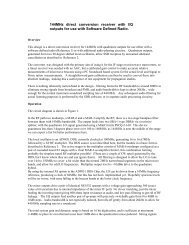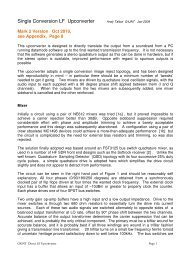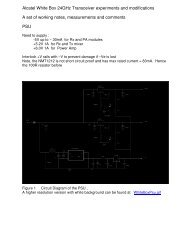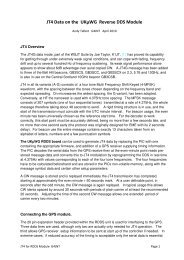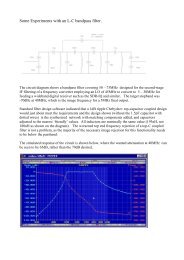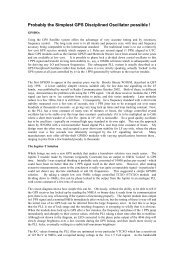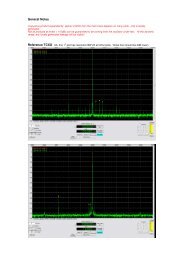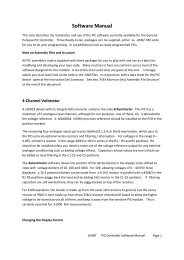The WSPR Coding Process I wanted a simple way of ... - G4JNT
The WSPR Coding Process I wanted a simple way of ... - G4JNT
The WSPR Coding Process I wanted a simple way of ... - G4JNT
You also want an ePaper? Increase the reach of your titles
YUMPU automatically turns print PDFs into web optimized ePapers that Google loves.
<strong>The</strong> <strong>WSPR</strong> <strong>Coding</strong> <strong>Process</strong><br />
I <strong>wanted</strong> a <strong>simple</strong> <strong>way</strong> <strong>of</strong> generating the symbols for programming into a <strong>WSPR</strong> beacon source<br />
consisting <strong>of</strong> a PIC microcontroller and DDS frequency generator. Whilst Joe, K1JT, has written a<br />
facility into the command-line s<strong>of</strong>tware, <strong>WSPR</strong>.EXE, to give a listing <strong>of</strong> the symbols, further<br />
processing is needed to extract the values into a useable form. I had written a programme for<br />
converting this list to a form suitable for import to PIC assembler file, but the process was messy and<br />
time consuming. (Ref 1) I also felt uncomfortable not knowing how the data was generated.<br />
<strong>The</strong> solution was to write my own s<strong>of</strong>tware to generate the <strong>WSPR</strong> symbols from first principles.<br />
(As I have an almost paranoid obsession with not using any data mode before I intimately know its<br />
structure and coding, this task would fulfil the necessary learning requirement…)<br />
Searching the web did not reveal any <strong>simple</strong> description <strong>of</strong> the encoding protocol, but did throw up<br />
the original source code for the complete WSJT s<strong>of</strong>tware (in Fortran and C) which was too<br />
complex to wade through. Also found were a couple <strong>of</strong> compilations by other writers, in both<br />
Python (Ref 2) and C, for generating the <strong>WSPR</strong> symbols based on this original source material.<br />
By studying and modifying the C code (and in the process having to learn and getting to quite like<br />
the C language) I managed to write s<strong>of</strong>tware that generates a .INC file for direct importation into<br />
PIC microcontroller code <strong>of</strong> the <strong>WSPR</strong> symbols for any given source message. Programmes in<br />
both C (derived from the original listing ) and Powerbasic were produced, and checked to ensure<br />
they both gave identical results, and agreed with data generated from the original <strong>WSPR</strong>.EXE<br />
s<strong>of</strong>tware.<br />
After all that, here is my description, in non language-specific terms, <strong>of</strong> <strong>WSPR</strong> encoding to assist<br />
others in understanding the complex encoding process.<br />
Source <strong>Coding</strong> :<br />
Input data consists <strong>of</strong> :<br />
(1) Callsign with a maximum <strong>of</strong> six characters consisting only <strong>of</strong> A-Z, 0-9 and [space]<br />
(2) Four digit locator (such as IO90)<br />
(3) Power level representing dBm from 0 to 60.<br />
All letters are converted upper case<br />
Callsign<br />
<strong>The</strong> third character is forced to be al<strong>way</strong>s a number. To cope with callsigns that start letter followed<br />
by a number, a space is appended to the front if necessary. So, for example, ‘<strong>G4JNT</strong>’ will become<br />
‘[sp]<strong>G4JNT</strong>’ whereas GD4JNT stays as-is. Short callsigns are then further padded out to six<br />
characters by appending spaces to the end<br />
<strong>The</strong> 37 allowed characters are allocated values from 0 to 36 such that ‘0’ – ‘9’ give 0 – 9, ‘A’ to ‘Z’<br />
give 10 to 35 and [space] is given the value 36. Further coding rules on callsigns mean that the<br />
final three characters (<strong>of</strong> the now padded out callsign) can only be letters or [sp] so will only take<br />
the values 10 – 36. With the characters, designated [Ch X], taking on values from 0 to 36 as<br />
defined, the callsign is now compressed into a single integer N by successively building up.
N 1 = [Ch 1]<br />
N 2 = N 1 * 36 + [Ch 2]<br />
N 3 = N 2 * 10 + [Ch 3]<br />
N 4 = 27 * N 3 + [Ch 4] – 10]<br />
N 5 = 27 * N 4 + [Ch 5] – 10]<br />
N = 27 * N 1 + [Ch 6] – 10]<br />
<strong>The</strong> first character can take on any <strong>of</strong> the 37 values including<br />
[sp] but the second character cannot then be a space.<br />
<strong>The</strong> third character must al<strong>way</strong>s be a number, so only 10 values are possible.<br />
Characters at the end cannot be numbers,<br />
so only 27 values are possible.<br />
Giving an absolute maximum value for N <strong>of</strong> 37 * 36 * 10 * 27 * 27 * 27 = 262177560<br />
Which is just comfortably less than 2 28 = 268435456 and means the callsign can be represented by<br />
28 bits with a range <strong>of</strong> codes left over for the future, eg. For allocation to special cases and flags.<br />
Locator<br />
Designating the four locator characters as [Loc 1] to [Loc 4], the first two can each take on the 18<br />
values ‘A’ to ‘R’ only so are allocated numbers from 0 – 17. <strong>The</strong> second pair can take only the<br />
values 0 – 9.<br />
Another integer M is formed from:<br />
M 1 = (179 - 10 * [Loc 1] - [Loc 3] ) * 180 + 10 * [Loc 2] + [Loc 4]<br />
Which gives a range <strong>of</strong> values from ‘AA00’ = 32220 to ‘RR99’ = 179, which comfortably fit into a<br />
15 bit representation (2 15 = 32768), leaving spare codes for further enhancements.<br />
Power level, [Pwr] is taken as a value from 0 – 60. Although only certain values will work with the<br />
WSJT / <strong>WSPR</strong> s<strong>of</strong>tware (just those ending in 0, 3 or 7) any <strong>of</strong> the possible 61 values will be<br />
encoded; Illegal values are labelled when decoded. Power in encoded into M by :<br />
M = M 1 * 128 + [Pwr] + 64 Which gives a final range <strong>of</strong> values for M up to a maximum <strong>of</strong><br />
4124287, and fits into 22 bits ((2 22 = 4194304)<br />
Bit Packing<br />
<strong>The</strong> total source data has now been reduced to 50 bits <strong>of</strong> data; 28 for the callsign in N with 15 for the<br />
locator and 7 for the power in M. A few special cases <strong>of</strong> coding are available for future<br />
enhancements like text messages, but these are not be covered here.<br />
<strong>The</strong> two integers N and M are truncated and combined so the 50 bits sit end-to-end as callsignlocator-power.<br />
<strong>The</strong>se are placed into an array <strong>of</strong> eleven 8-bit bytes c[0] to c[10], so the first element<br />
c[0] contains the most significant 8 bits part <strong>of</strong> the callsign, c[1] the next 8 bits and so on. (Note that<br />
c[3] contains both the 4 LSBs <strong>of</strong> the callsign and 4 MSBs <strong>of</strong> the locator, and that c[6] contains just<br />
the two LSBs <strong>of</strong> M occupying the most significant bit positions. <strong>The</strong> lowest six bits <strong>of</strong> c[6] are set<br />
to 0, with the remaining byte-array elements [c7] to c[10] set to zero. Only the left-most 81 <strong>of</strong><br />
these 88 total bits are subsequently used.<br />
An alternative view is to imagine them as an 81 character-long string containing characters ‘0‘ and<br />
‘1’ only.<br />
Convolutional Encoding
<strong>The</strong> data is now expanded to add FEC with a rate ½, constraint length 32, convolutional encoder.<br />
<strong>The</strong> 81 bits (including the 31 trailing zeros) are read out MSB first in the order:<br />
c[0] MSB… c[0] LSB., c[1] MSB…c[1] LSB ………… c[11]<br />
(or adopting the alternative view, one-at-a-time from the left hand end <strong>of</strong> the string)<br />
<strong>The</strong> bits are clocked simultaneously into the right hand side, or least significant position, <strong>of</strong> two 32<br />
bit shift registers [Reg 0] and [Reg 1]. Each shift register feeds an Exclusive-OR parity generator<br />
from feedback taps described respectively by the 32 bit values 0xF2D05351 and 0xE4613C47.<br />
Parity generation starts immediately the first bit appears in the registers (which must be initially<br />
cleared) and continues until the registers are flushed by the final 31 st zero being clocked into them.<br />
Each <strong>of</strong> the 81 bits shifted in generates a parity bit from each <strong>of</strong> the generators , a total <strong>of</strong> 162 bits in<br />
all. For each bit shifted in, the resulting two parity bits are taken in turn, in the order the two<br />
feedback tap positions values are given, to give a stream <strong>of</strong> 162 output bits.<br />
<strong>The</strong> parity generation process is :<br />
Shift the next source bit into the LSB <strong>of</strong> both [Reg 0] and [Reg 1],<br />
moving the existing data in each one place left<br />
Take the contents <strong>of</strong> [Reg 0]<br />
AND with 0xF2D05351<br />
Calculate the single bit parity (XOR) <strong>of</strong> the resulting sum.<br />
Append to the output data stream<br />
Take the contents <strong>of</strong> [Reg 1]<br />
AND with 0xE4613C47<br />
Calculate the single bit parity (XOR) <strong>of</strong> the resulting sum.<br />
Append to the output data stream<br />
<strong>The</strong> expansion from 50 source data bits to 162 has added sufficient redundancy in an optimised<br />
manner to give a code capable <strong>of</strong> very strong Forward Error Correction against random errors.<br />
Interleaving<br />
Errors over a radio link are rarely random , being more likely to occur in bursts against which this<br />
sort <strong>of</strong> convolutional coding is less effective,. So the final stage <strong>of</strong> encoding is to mix up, or<br />
interleave. the 162 data bits so as to move adjacent bits a<strong>way</strong> from each other in time. <strong>The</strong> result is<br />
that close-together bits corrupted by burst interference are spread throughout the frame and therefore<br />
appear as random errors – which the FEC process can cope with.<br />
<strong>The</strong> interleaving process is performed by taking the block <strong>of</strong> 162 starting bits labelled S[0] to<br />
S[161] and using a bit reversal <strong>of</strong> the address to reorder them, to give a pattern <strong>of</strong> destination bits<br />
referred to as D[0] to D[161].
Initialise a counter, P to zero<br />
Take each 8-bit address from 0 to 255, referred to here as I<br />
Bit-reverse I to give a value J.<br />
For example, I = 1 gives J = 128, I = 13 J = 176 etc.<br />
If the resulting bit-reversed J yields a value less than 162 then :<br />
Set Destination bit D[J] = source bit S[P]<br />
Increment P<br />
Stop when P = 162<br />
This completely shuffles and reorders the 162 bits on a one-to-one basis.<br />
Merge With Sync Vector<br />
<strong>The</strong> 162 bits <strong>of</strong> data are now merged with 162 bits <strong>of</strong> a pseudo random synchronisation word having<br />
good auto-correlation properties. Each source bit is combined with a sync bit taken in turn from the<br />
table below to give a four-state symbol value:<br />
Symbol[n] = Sync[n] + 2 * Data[n]<br />
Modulation<br />
162 bit Synchronisation Vector<br />
1,1,0,0,0,0,0,0,1,0,0,0,1,1,1,0,0,0,1,0,0,1,0,1,1,1,1,0,0,0,0,0,0,0,1,0,0,1,0,1,0,0<br />
0,0,0,0,1,0,1,1,0,0,1,1,0,1,0,0,0,1,1,0,1,0,0,0,0,1,1,0,1,0,1,0,1,0,1,0,0,1,0,0,1,0<br />
1,1,0,0,0,1,1,0,1,0,1,0,0,0,1,0,0,0,0,0,1,0,0,1,0,0,1,1,1,0,1,1,0,0,1,1,0,1,0,0,0,1<br />
1,1,0,0,0,0,0,1,0,1,0,0,1,1,0,0,0,0,0,0,0,1,1,0,1,0,1,1,0,0,0,1,1,0.0,0<br />
Resulting in 162 sequential symbols each with a value from 0 to 3<br />
Each symbol represents a frequency shift <strong>of</strong> 12000 / 8192, or approximately 1.46Hz, per Symbol<br />
Value giving four-level Multi-FSK modulation. <strong>The</strong> transmitted symbol length is the reciprocal <strong>of</strong><br />
the tone spacing, or approximately 0.683 seconds, so the complete message <strong>of</strong> 162 symbols takes<br />
around 110.6 seconds to send and occupies a bandwidth <strong>of</strong> approximately 6Hz,<br />
Packing for export and storage<br />
For export, the 162 two-bit symbols are packed four to a byte, MSB first, into 41 locations.<br />
Ref 1 http://www.g4jnt.com/beacons.htm<br />
http://www.g4jnt.com/<strong>WSPR</strong>BCNS.ZIP<br />
Ref 2 http://brainwagon.com/files/genwspr<br />
Andy Talbot <strong>G4JNT</strong> June 2009



